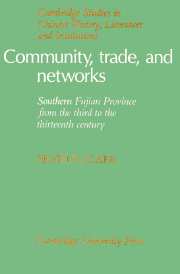Book contents
- Frontmatter
- Contents
- List of maps and tables
- Acknowledgments
- 1 Problems and approaches
- 2 The late Tang
- 3 The interregnum: politics, structure, and administration
- 4 The interregnum: society and economics
- 5 The Song: demography and networks
- 6 The Song: trade and economy
- 7 Conclusions
- Appendix 1 Townships (xiang), villages (li), and command brigades (dubao) under the Song
- Appendix 2 A discussion of population distribution
- Appendix 3 Pre-Song and Song bridges by district in twenty-five-year intervals
- Appendix 4 Place names in the Yunlu manchao and Zhufan zhi
- Appendix 5 Abbreviations
- Notes
- Glossary
- Bibliography
- Index
4 - The interregnum: society and economics
Published online by Cambridge University Press: 13 October 2009
- Frontmatter
- Contents
- List of maps and tables
- Acknowledgments
- 1 Problems and approaches
- 2 The late Tang
- 3 The interregnum: politics, structure, and administration
- 4 The interregnum: society and economics
- 5 The Song: demography and networks
- 6 The Song: trade and economy
- 7 Conclusions
- Appendix 1 Townships (xiang), villages (li), and command brigades (dubao) under the Song
- Appendix 2 A discussion of population distribution
- Appendix 3 Pre-Song and Song bridges by district in twenty-five-year intervals
- Appendix 4 Place names in the Yunlu manchao and Zhufan zhi
- Appendix 5 Abbreviations
- Notes
- Glossary
- Bibliography
- Index
Summary
The reader should have a sense from the preceding chapter of the complexity of the interregnum period. Because of the unusual politics of the era, Quannan, like most areas of the South, was forced to rely on its own resources in ways that were unknown during times of integration under a centralizing empire. For the first time in its short history, Quannan could not depend on the talents of men from elsewhere to administer its affairs. As we have seen, the warlords of the late interregnum relied heavily – perhaps entirely – on natives of Quannan to staff their administrative structures, thus initiating a tradition that was to make Quannan a major political center of the succeeding Song. To pay for the dual burdens of self-administration and local defense, local government initiated new taxes similar to those found elsewhere in south China but significantly different from those of earlier eras. Inevitably this interplay of events and policies influenced local society and the economy. In this chapter I shall explore its impact on demography, patterns of landholding, and the growing importance of commerce.
Demographic change
The late ninth and early tenth centuries were an era of great unrest and demographic upheaval across China. Just as the combined rebellions of An Lushan and Shi Siming in the mid-eighth century had led to a great wave of migration from North to South, so the late-ninth-century turmoil surrounding the rebellion of Huang Chao and the subsequent chaos of the North that accompanied the collapse of Tang legitimacy prompted a massive relocation toward the more stable South.
- Type
- Chapter
- Information
- Community, Trade, and NetworksSouthern Fujian Province from the Third to the Thirteenth Century, pp. 52 - 70Publisher: Cambridge University PressPrint publication year: 1991



